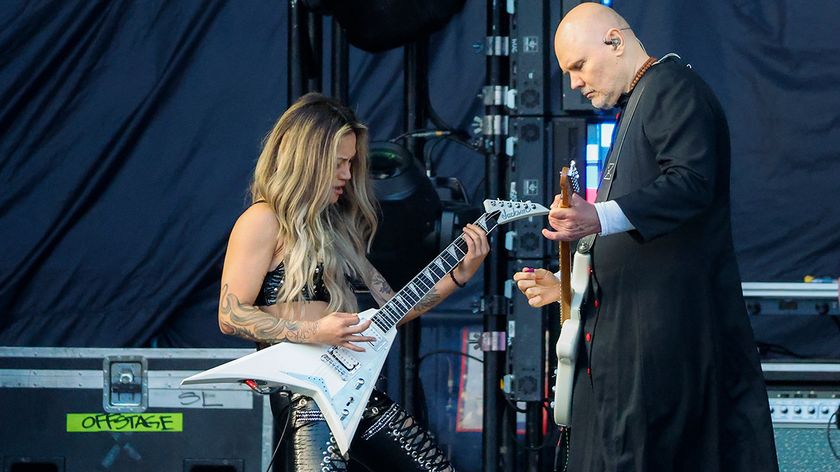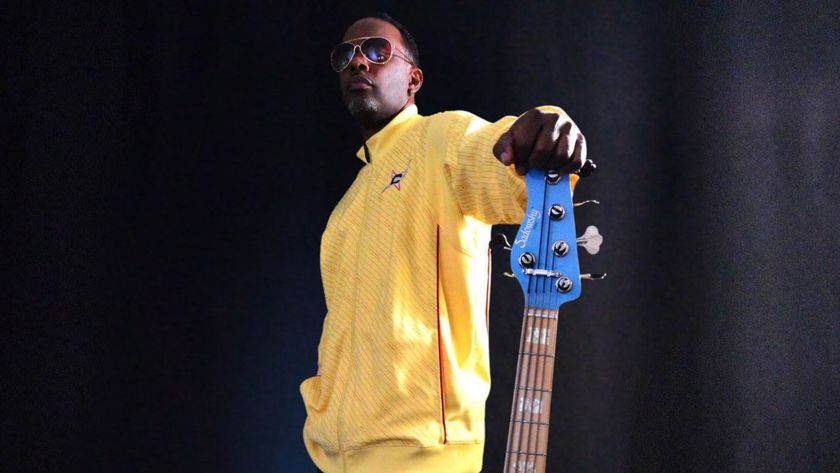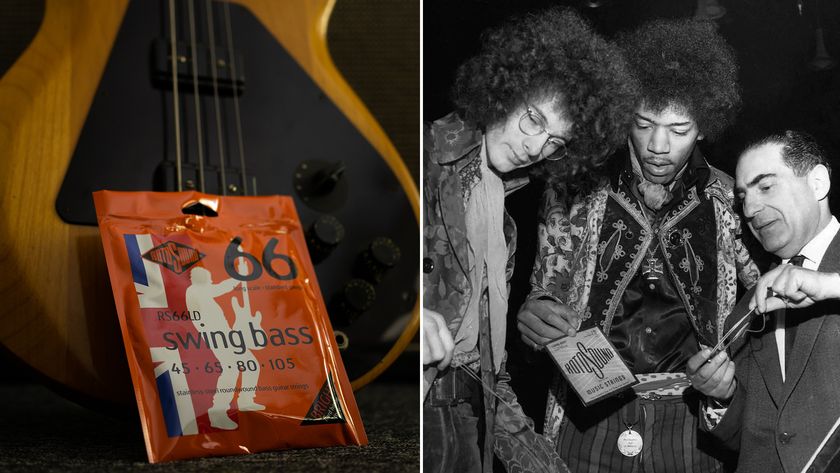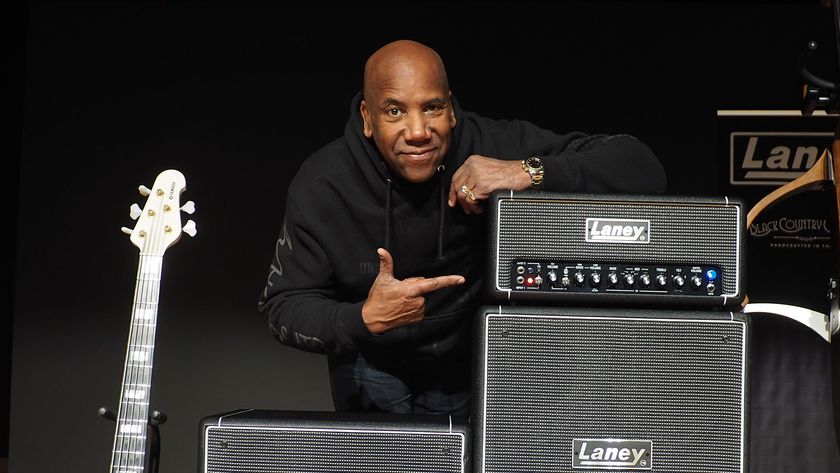Joe Satriani: Hey Joe
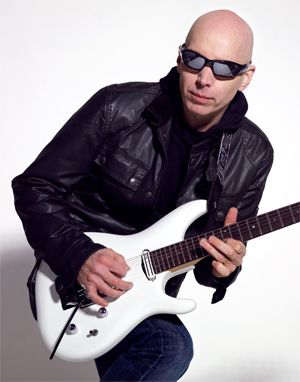
Originally published in Guitar World, April 2010
He played an extended world tour in 2008 and spent the past year performing with Chickenfoot and readying his brand-new DVD, Live in Paris. So where is Joe Satriani going with that ax in his hand? Straight onto the 2010 Experience Hendrix Tour, that’s where.
For the past two years, Joe Satriani has been in perpetual-burn mode, with little time to relax, let alone reflect. In 2008, he released the solo album Professor Satchafunkilus and the Musterion of Rock and embarked on a lengthy world tour. Last year, the man who virtually redefined instrumental guitar rock realized his lifelong dream of forming an honest-to-goodness vocal-oriented band with Chickenfoot, which includes Sammy Hagar, bassist Michael Anthony and Red Hot Chili Peppers drummer Chad Smith.
Touchdowns were duly scored. The well-received Professor Satchafunkilus satisfied music fans starved for audacious, yet beautiful, shred—the kind of big-time guitar-god stuff few players can pull off. As for Chickenfoot, they were an odds-defying, not-so-littleengine that could—a gang of middle-aged vets whose debut album was filled with high-energy, riff-heavy, hot-and-horny rock that kicked a donkey’s ass. That it was certified Gold in this day of eroding CD sales stunned many. Even the band’s members were surprised by what they’d achieved. “We thought, Hey, if the record allows us to play shows, that’s great,” Satriani says. “But to go Gold, that was some icing on the cake, boy.”
For Satch, 2009—the Year of the Chickenfoot—was an astounding achievement. And there is still more to come. “It’s like, there are no words for it,” Satch says. “That we were able to work with everybody’s schedules and become a living, breathing entity; how we wrote, recorded and finished an album that we could be proud of; that we toured the world and found that people were still hungry for a brand-new band, playing music they’d never heard before but wound up loving—it’s totally wild. I’m ready for a rest, but I’m very happy with what we accomplished.”
“Rest” is something of a subjective term for the 53-year-old guitarist. He’s just released the DVD Live in Paris: I Just Wanna Rock and a two-CD companion collection that captures his Satchafunkilus show in a stereo mix that puts you front and center. At times it feels as though you’re onstage with Satch and his long-time rhythm section of drummer Jeff Campitelli and bassist Stu Hamm, during a bracing 22-song set that combines classics like “Satch Boogie” and “Ice 9” with a generous helping of new cuts.
“It was a great night, so I’m glad we got it on film,” Satriani says. “Many times on any given tour I find myself saying, ‘Man, we’re pretty damn great tonight. We should’ve filmed this one.’ For that Paris show at the Grand Rex Theater, we really got it right.”
Get The Pick Newsletter
All the latest guitar news, interviews, lessons, reviews, deals and more, direct to your inbox!
Now Satch is primed to take part in the 2010 Experience Hendrix Tour, on which he’ll share stages with the likes of Eric Johnson, Kenny Wayne Shepherd, Billy Cox, Sacred Steel featuring Robert Randolph, Jonny Lang, Ernie Isley, Brad Whitford, Doyle Bramhall II, Living Colour, Hubert Sumlin and Chris Layton. The tour hits 17 cities throughout March, and Mr. “I’m Ready for a Rest” can’t wait to get on the bus. After all, Satriani famously quit his football team at age 14 when he heard of Hendrix’s death, vowing to devote his life to playing the guitar.
“I think everybody knows how much I revere Jimi Hendrix,” he says. “So for me to get a chance to honor my hero in such a terrific way, with an amazing group of players, come on, it’s a dream come true.”
GUITAR WORLD Are you having a hard time coming down from your year of Chickenfoot?
JOE SATRIANI Yes, I am. Funnily enough, I was just talking to Sammy about this very thing. We both had some solo gigs to do after shutting down Chickenfoot last December, and we compared notes about how strange it was to go back to being the artists we once were. We found that we’d experienced the exact same phenomenon: we picked up our guitars and started playing songs that we’d performed for 20 years or more, and everything was just…blank. [laughs]
For example, in my case, I was getting ready to do a little show with Jeff Campitelli and Stu Hamm, and I actually had to go back and listen to “Flying in a Blue Dream.” It was like, Now, how did I used to play that? [laughs] Little things that I thought I knew like the back of my hand I had to reacquaint myself with. Totally crazy, right?
Also, there was a physical element of playing the guitar with Chickenfoot—using heavier strings tuned down, and then going back to my normal routine of using .009s tuned to standard pitch—that was throwing me off a little bit. It’s going to take a while to come down from such an incredible year, but I’m so grateful for all that’s happened.
Sammy and I realized how much space in our brains Chickenfoot took because it was so fresh and new. Suddenly, we were this band and we operated in a different way than what we were used to. Going back to playing solo is going to take a period of readjustment.
GW We’d spoken about this previously, how you had wanted for so long to be in a vocal-oriented rock band. And now its happened, and it was a success.
SATRIANI It’s totally mind blowing. And I think the real important thing is that Sammy, Mike, Chad and myself formed a real connection. We didn’t break up after the record was made; we didn’t break up after the first tour and the second tour. That we were all able to look one another in the eye at the end of the run and say, “Chickenfoot is a band and we have more to do,” that’s the greatest thing to come out of all of this.
GW With Chad back in the Chili Peppers for what might be a year or two, are you going to try to work around his schedule? Are you going to write and demo songs without him?
SATRIANI Actually, we planned ahead by writing while on tour. Before we went onstage, we’d play in the dressing room and record what we were doing. So there’s a batch of ideas and half songs already floating around that could be Chickenfoot songs, and we made a plan to get together this year, whenever possible, to flesh them out more. Even with Chad in the Chili Peppers, I think we’ll be able to do it. He won’t be recording all the time—the Chili Peppers take breaks, sometimes a few of them, during all their records. Chad will be available. Like we did before, with everybody’s crazy schedules, we’ll be able to get Chickenfoot songs in the can. To tell you the truth, I’m welcoming what might be extra time. The first record was a little rushed. We might be able to give the second record a little more love.
GW Josh Klinghoffer has recently taken the place of John Frusciante in the Chili Peppers. So tell me, why didn’t you get the gig?
SATRIANI [laughs] Yeah, why not, right? Hey, it’s not like I didn’t drop hints: I played some Chili Peppers songs backstage, hoping Chad would pick up on it. Actually, I was pretty shocked to hear the news that John Frusciante had quit again. I thought [the group’s 2006 album] Stadium Arcadium was a terrific record that really showed off his playing. It’s was the most “John Frusciante” of all their albums. Chad never mentioned that John was leaving, at least not to me. It’s a pretty big deal for the band. We’ll see what happens.
GW Last year was a pretty tumultuous one for you, too, with the Coldplay lawsuit. [Satriani sued Coldplay in December 2008 alleging their song “Viva La Vida” infringed the copyright to his 2004 track “If I Could Fly.” The case was dismissed in September 2009. The details remain sealed, and Coldplay were not required to admit any wrongdoing.] Without going into details, any thoughts as to its resolution?
SATRIANI I can only say, “No comment.”
GW But still, you must be relieved that it’s over.
SATRIANI Oh, sure. No musician likes to go through a lawsuit. Musicians want to spend their time making music, not talking to lawyers and dealing with all that stuff. I don’t think anybody enjoys that kind of thing.
GW How did you find the time to put together the Live in Paris set?
SATRIANI The truth is, most of it was done pre-Chickenfoot. At least the shooting was. Like most live sets and DVDs, they’re borne out of opportunity. When you’re not thinking about it, somebody comes up and says, “Hey, would you like to be filmed doing this show?” and that happened when we were getting ready to do our tour of Europe in 2008. I thought the idea of being filmed at the Grand Rex Theater in Paris was great—it’s such a wonderful venue.
The director, Gunther Kutsch, was a really cool guy who presented some terrific ideas. We talked about the way I have a hard time staying in reality when I’m performing—it’s like I become this different person almost, and I’m seeing movies in my head for each song. So we talked a lot about that, about bringing that emotional rollercoaster that I’m feeling and presenting it visually. I think he pulled it off.
GW Visually, it does have a lot more impact than your previous live DVDs.
SATRIANI That’s true. My other live DVDs were pretty straight-ahead. I’m not knocking them, but this one is more interesting visually. Also, the band didn’t suck the night we filmed it! [laughs]
GW There’s a selling point right there.
SATRIANI I would hope so. “Check it out—we don’t blow!” [laughs] You know, we didn’t go out and film 20 shows and edit them together and pick the best takes of each song. It was one night—boom! I was telling myself backstage, “Joe, you’d better be good tonight ’cause the cameras are rolling.” And the great thing is, luck was on my side that night. Once in a while on every tour you get those golden moments when it just seems that everything is right: your amp feedback is perfect, your performance of a particular song is the best it’s ever been, the band rocks harder than ever... That night in Paris was one of those nights. Oh, and I didn’t trip and fall down, which actually has happened. [laughs]
GW For the tour, your band consisted of Jeff Campitelli on drums, Stu Hamm on bass and Galen Henson, who plays rhythm guitar and doubles as tour manager. Did you have to throw Galen extra bucks to be part of the band?
SATRIANI [laughs] He’s the highest-paid man on the whole tour. He was a bass tech on the G3 Tour, and one night, as we were getting ready to hit the road, I heard this great guitar playing coming from another room in the practice studio. I walked in, and it was Galen. I couldn’t believe how well he played. So I asked him, “Any chance you can play ‘Always with Me, Always with You’ for me?” Which he did, right there and then, perfectly. So afterward I said, “Hey, do you think you could come out onstage and play three songs?” because we were doing kind of the trio thing and I wanted to beef up the sound a bit. The whole thing expanded to him doing three more songs, and three more songs, and by the time of the Satchafunkilus tour, it made sense to have him be a part of the band.
GW Tell me about Stu. How has working with him changed over the years?
SATRIANI Stu’s great. He’s a very musical bass player with deep roots in funk, jazz, classical, fusion... He’s always seemed to me to be a brand-new rock enthusiast—and this is going back over 20 years ago when I first met him. I don’t think he knew more than three Led Zeppelin tunes at the time, but during our times together he would sort of blossom into this other area. Check out the Time Machine record, where he was experimenting with distorted bass. He was going for the rock there. I think he was even wearing a bunch of chains around his neck and stuff. [laughs] He really threw himself into it. And what’s great about him is he takes risks. He pushes himself, and that pushes me. He’s the one guy who can maybe do something fusion-y and I’ll respond to it, whereas that might not work with somebody else. He brings me the balance I need.
GW The set list has a good combination of your classics and selections from Professor Satchafunkilus. While you were touring, did you ever find certain new songs weren’t working, or did they all hit the mark right off?
SATRIANI At the beginning of the tour, we thought some of the new songs might be difficult to play live, from the standpoint of both playing and audience reaction, but we decided to do as much of the new album as we could. There was one new song, though, called “Andalusia” that was extremely taxing for me, personally. We’re talking five minutes of fast physical playing. So I was quite happy to put the bass solo directly afterward so I could have a break. [laughs]
GW The new songs sparkle, but clearly you still have a great time playing the older songs.
SATRIANI I love playing the old songs. The other night, in fact, I played “Ice 9,” “Satch Boogie” and “Summer Song” with Jeff and Stu, and it was a blast. It’s always fun to see if I can find new elements in them. When I make a record, a lot of the time what you hear is me playing a song for the first time. But as the years go by and I play songs hundreds and thousands of times all over the world, that’s when the songs grow up in a way. They become something else, and I’m always discovering something about them. It’s a fascinating phenomenon.
GW You change guitars a fair amount during the show. Of your signature Ibanez models, are there certain songs that call for particular guitars?
SATRIANI My main reason for changing guitars is that I want to make sure they’re always in tune. I like talking to the audience and explaining this song or that song, but I don’t enjoy trying to make small talk while I’m trying to tune a guitar. Who wants to hear me telling lame jokes while I’m looking down at my guitar, you know? [laughs]
GW The DVDs and CDs sound amazing.
SATRIANI Thanks. Music is played through so many different types of speakers these days, and it’s become harder to make it sound uniform. You know, if your music is coming out of ear buds, a home theater system, a computer or ceiling speakers in Jack in the Box, you still want it to sound great, but you want it to sound uniform; you want it to sound the way it’s supposed to sound, no matter where you are or whatever device you’re hearing it through. One way around that is to make the sound compact and full of every bit of fidelity you can. This is where limiting [dynamic audio compression] comes into play, because it allows the subtletiesto come out.
GW Tell me about your decision to perform on the Experience Hendrix Tour. I assume you’ve been asked to be on the tour in the past. What led to your decision to do it now?
SATRIANI Well, I’ve always wanted to do it, but this year the timing was perfect. That was a big consideration. Since I didn’t know if there was going to be any live Chickenfoot activity this year, I told my manager that I didn’t want to just go home and start on a new solo album; I wanted a bit of a break. Even so, the idea of doing something new appealed to me. So when the Hendrix tour popped up, it sounded great: It was only one month; I’d be playing a few songs instead of all the songs; and the best thing was, they’re songs I already know by heart—I don’t have to go off and learn a bunch of new material. So it made sense on every level. And then when I saw who else was going to be part of the tour, I said, “Yes! I want to hang out with these guys and play with them.” It was a very easy decision to make.
GW I assume you’ve seen previous Experience Hendrix shows.
SATRIANI Actually, only the one that I played on. A number of years ago I played a couple of songs at the show in San Francisco. Jerry Cantrell was on the bill, as was Mitch Mitchell, Billy Cox, Buddy Guy… It was one of the first ones they did; it wasn’t the full-blown setup that it is now. But I thought it was amazing, like a big, crazy revue-type show, you know? [laughs] Now it’s grown considerably. On this tour we’ve got Ernie Isley, Brad Whitford, Eric Johnson, Doyle Bramhall II , Living Colour—they’re going to be my backup band, so I’m really looking forward to that.
GW You’ve played various Hendrix songs live in the past—“Purple Haze,” “Little Wing,” “Hey Joe,” “May This Be Love”… Any thoughts as to what you’re going to play on the tour?
SATRIANI I threw my hat in the ring and said that I’d love to play “Foxy Lady,” “Third Stone from the Sun”… I like the idea of a good mixture. There have been some Hendrix songs I’ve played on G3 tours that people have seen, so I’d like to shake it up a bit. One song I really want to do is “All Along the Watchtower.”
GW That’s an interesting selection, and it raises a question: Bob Dylan wrote it, but Jimi popularized it. At this point, when you hear it or play it, who do you think of: Dylan or Hendrix? Do you feel as though Hendrix, in a sense, “owns it”?
SATRIANI I think of both Hendrix and Dylan. Dylan’s original is focused on the powerful lyrics and their delivery, whereas Jimi’s is a full-blown musical fantasy, with the message carried in one of his best vocal performances. Jimi’s version is a crystallization of ’68 and ’69.
GW Jimi Hendrix is, of course, your biggest musical influence. When you perform his music, do you have to get into a particular frame of mind?
SATRIANI I do, but I’ll tell you, it literally takes seconds. [laughs] Half the time, I think I’m there anyway. The only tricky matter when it comes to playing Jimi’s music is the gear, because when you really identify with a particular set of recordings and you go to play them live, you can’t help but think that maybe you should have that exact gear to get as close to that sound and vibe as possible. But in the case of those songs I just mentioned, it’d be impossible—even the gear Hendrix was using was completely different for those three tracks. To put those elements together for a quick three-song set…good luck! [laughs]
But I think you have to remind yourself that the audience is there to see you interpret the material, so you have to be yourself. Getting caught up in all kinds of details, that’s no way to perform. It’s too cerebral. You’d drive yourself crazy saying, “Okay, Jimi did this here, so I’m gonna do it just like him. And for this song I’m gonna play the white Strat and wear the scarf…” [laughs]
It can get silly if you let it. The key is the music. When I look back at Jimi’s short, but amazing, career, his live performances were completely off the charts. I mean, he was absolutely crazy at improvising and changing and railing against his own records. Why would anybody think that you have to go out there and recreate his records note for note, tone for tone, piece of gear for piece of gear? I just don’t think that’s true to his spirit. He’d be the first guy to tell you do your own thing.
GW You’re now back to playing Marshall amps. Do you consider them the perfect amplifier with which to play Jimi’s music?
SATRIANI Yeah, I’m really loving these JVMs that I’ve got right now. I’m working with a designer at Marshall to see if we can come up with an unusual amplifier I can call my own. I’ve got a ton of Marshalls. In fact, I routinely buy a lot of old Marshall amps for each record—some of them get used, some are just for reference—and then I wind up selling them at the end of the year. Sometimes I think, Why don’t I just keep them, you know? [laughs] But you can’t keep everything. Otherwise, I would have over 100 Marshall amps by now.
I am digging them, though. Marshall amps have body. By that, I mean, the sound that comes out of them has weight, a shape that’s malleable. All the frequencies are covered. But you know, Hendrix didn’t only play Marshalls. On the first record, he borrowed Noel Redding’s Telecaster, and he used a Fender Twin on a few songs. The difference is, he was Jimi Hendrix! [laughs] You give me a Telecaster and a Fender Twin and I’d get nervous.
GW But as you point out, that was for recording. Did he ever use that setup live?
SATRIANI No. He realized that recordings and live performances were two different animals. What he used in the studio wasn’t necessarily what he used onstage.
GW On this tour, is there anybody in particular you’re looking forward to playing with?
SATRIANI Are you kidding? Everybody! [laughs] I look at the list and I’m like, “This is amazing!” I think one of the things they might do is have a kind of rotating jam, and it’ll be different night to night. A lot of the playing will probably go on during the soundchecks and backstage. There will be plenty of time for the musicians to trade licks and compare notes and have fun.
I’m a big Doyle Bramhall fan, so I can’t wait to play with him. I love his writing, his playing, his singing—the guy’s unreal. I’ve tried to get him on a couple of G3 tours and it never worked out. He’s really something. I don’t know if I have anything to add to what he does. I might just stand on the side of the stage and go, “Wow!”
And Brad Whitford, too, he’s great. When he starts playing, it’s so solid and so right and so perfect that you just want to back him up and let him go.
GW Do you feel he’s underrated? He’s always seemed to be in the shadow of Joe Perry.
SATRIANI Certainly. I mean, I don’t know the Aerosmith band politics, but both of them are fantastic, and they each have their own identifiable sounds and styles. Joe’s guitar does seem to lead the Aerosmith engine, but Brad is a really powerful player. I can’t wait to mix it up with him—and everybody. This is going to be like going to one of those rock and roll camps, only we get to play Hendrix every night. What can be bad about that?
I just can’t wait to get out there and see the reaction from the crowd. Jimi’s music touched people in so many profound ways. I imagine there will be a mixture of young and old fans, all there to pay tribute to the master that Jimi Hendrix really was. His music lives, man. It’s as vital today as when he recorded it.

“Freddie King would ask me why I never tried using thumbpicks – I just couldn't play with one”: He took Jimi Hendrix's place in Little Richard's band, was idolized by Stevie Ray Vaughan, and is one of the most overlooked Telecaster slingers of all time
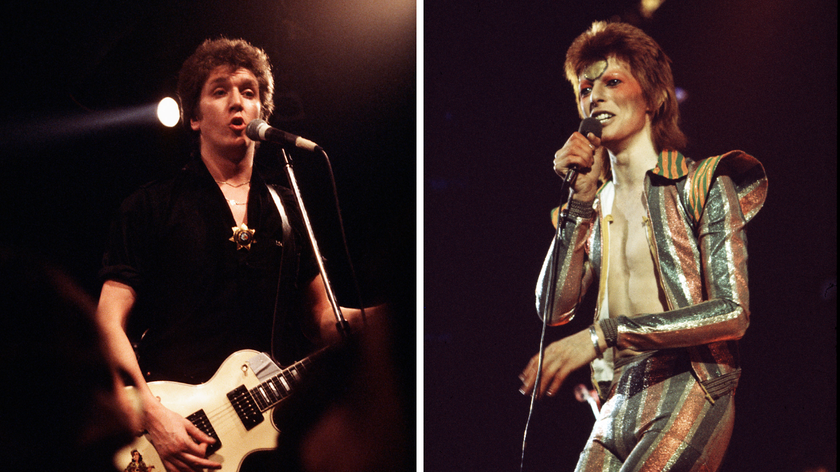
“I nicked some cymbals, the bass player’s amp head and some microphones. I got Bowie’s microphone with his lipstick on it!” On July 3, 1973, David Bowie retired Ziggy Stardust – that same day, Steve Jones stole his equipment
